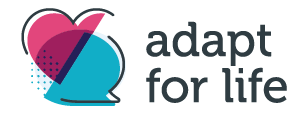
Frequently Asked Questions (FAQs)
What is Adapt for Life?
Adapt for Life (AFL) is a mental health and wellbeing education program for students, grades K-12. AFL enables children and adolescents to become mentally fit by helping them build healthier habits and skills, including self-awareness, self-management, social awareness, relationship skills, and responsible decision-making.
Adapt for Life program is an experiential, modular workshop that offers videos, mindfulness exercises, group activities, interactive surveys, and moments for reflection. We teach the program to schools across the region and bring challenging topics into the light. We provide the expertise, the program curriculum, and wrap-around support, so students, educators, and families are better equipped to support a child suffering with mental illness or struggling with mental health.
Who leads and sponsors the program?
Adapt for Life was developed in partnership with Cincinnati Children’s Hospital Medical Center (Cincinnati Children’s), one of the nation’s leading health centers for children in the United States. Our facilitators are clinically trained and follow a structured curriculum that has been vetted by mental healthcare professionals.
How does this program help families and educators who support those students?
Adapt for Life offers families and educators support by:
FAMILIES
Informing you about the program topics taught to your student(s).
Helping you become more knowledgeable on topics related to the continuum of mental health in children and adolescents.
Increasing awareness of how mental health symptoms may be expressed in children and adolescents and what to look for or possible warning signs for student(s) in need.
Providing you with tools and resources to help or get help for your student(s).
Guiding you on how to have the conversation about mental health with your student(s).
EDUCATORS
Providing the expertise and necessary materials to deploy the program either in person, virtually, or a blended approach.
Fostering an experience that strengthens relationships.
Helping you understand your own feelings, thoughts, and behaviors as well as those of your peers and students, which can lead to greater self-awareness.
Providing a mental health and wellbeing curriculum that integrates Ohio SEL and PBIS competencies.
Guiding you on how to have the conversation about mental health with your student(s).
Where is Adapt for Life currently taught?
Adapt for Life is currently offered to schools in the Greater Cincinnati Tri-State area. Our program has reached 70 schools and over 100,000 students, educators, and families.
What are the future goals and vision for this program?
We want to get Adapt for Life to as many young people as possible. This means reaching more students in more schools and connecting with parents and teachers in more significant and meaningful ways.
Why are we offering this program?
Suicide is a national epidemic, and there is an acute need for action. In Ohio, suicide is the leading cause of death for children 10-14 years and the second leading cause of death for ages 15-34 years. Nationally, suicide is the second leading cause of death for people ages 10-34 years. In the United States, suicide continues to trend at more than twice the rate of homicides, with one person dying by suicide approximately every 10 minutes.
Between 2007-2018, the rate of youth suicide (10-24 years) increased 64.4% from 7.3 to 12.0 deaths per 100,000. More recently, research shows that suicide rates in teenagers have dramatically increased in the last five years, with a significant jump in ages 11-12 years. Educating students on mental health is a way to reach and help students before there is a crisis. Adapt for Life teaches students about mental illness, such as depression and suicidal behavior, in an effort to close the gap in services for children and adolescents struggling with mental health.
How does this program help students?
Through Adapt for Life, students will:
Develop greater self-awareness and have a deeper understanding of their individual feelings, thoughts, and behaviors.
Enhance their observation and listening skills in order to describe what they see or hear in real-life scenarios.
Understand the range of stressors, become aware of their personal triggers, and learn adaptive skills for coping with their stress.
Learn to identify warning signs of suicidal behavior.
Learn about common obstacles to seeking help for themselves or to help others.
Recognize and assess behavior changes in themselves and/or others.
Develop a plan for coping with everyday stress or in times of crisis.
Practice having conversations with others about mental health and reduce the stigma around mental illness.
Learn about resources available to them and others so they can thrive.
Identify trusted adults in their life whom they can talk with or turn to in times of stress or crisis.
Engage in a variety of ways to reduce stress including mindfulness exercises, gratitude journaling, and other activities to do on their own or with others.
How does Adapt for Life help students address issues related to mental health and mental illness?
Adapt for Life helps students by providing opportunities for them to practice new and better coping behaviors and skills through real-life scenarios. Students also engage in a variety of exercises that promote healthy habits and help them proactively manage stress. The program gives students tools and resources they can use in moments of need or during times of crisis.
What is the ADAPT framework?
The ADAPT framework—Ask, Describe, Assess, Plan, and Talk—is a model we use to help students develop healthy behaviors and important life skills to tackle stress, whether it’s during everyday moments or in times of crisis. The ADAPT framework makes it easy for students to connect and apply the lessons and skills taught in class to their personal lives.
Ask questions to gain awareness.
Describe thoughts, feelings, and behaviors.
Assess behaviors, obstacles, and warning signs.
Plan how to ask for help and/or voice concern.
Talk with a trusted adult about what’s going on.
